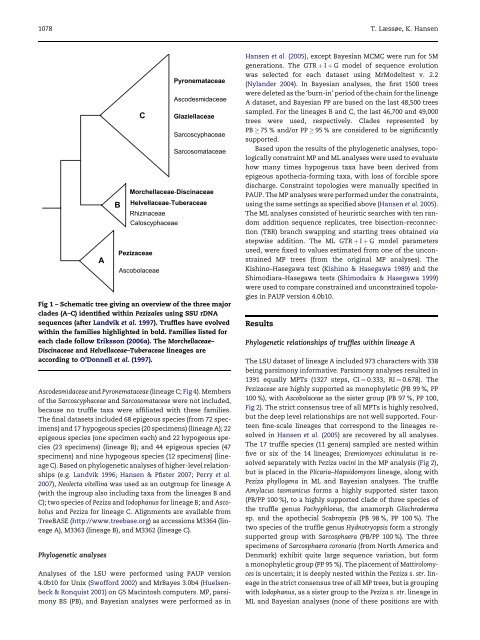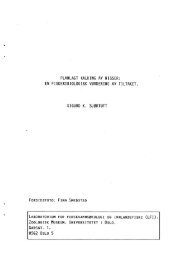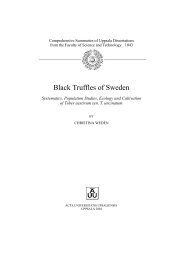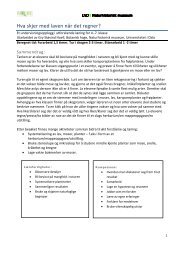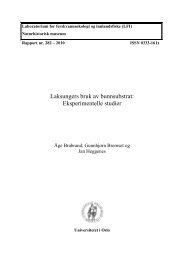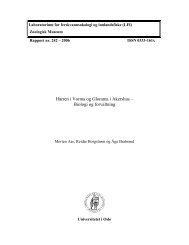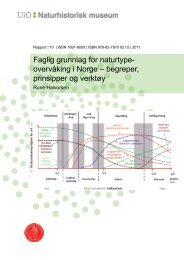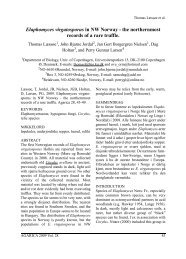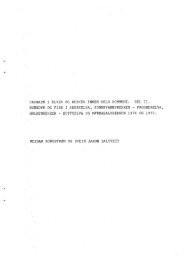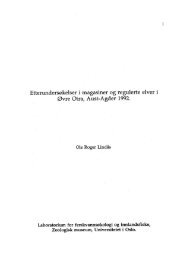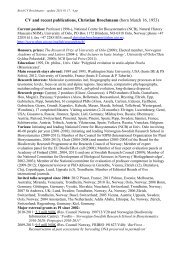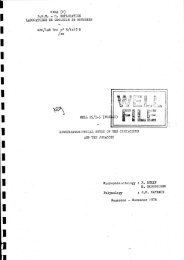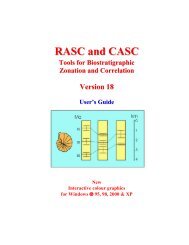Truffle trouble: what happened to the Tuberales?
Truffle trouble: what happened to the Tuberales?
Truffle trouble: what happened to the Tuberales?
- TAGS
- truffle
- www.nhm.uio.no
Create successful ePaper yourself
Turn your PDF publications into a flip-book with our unique Google optimized e-Paper software.
1078 T. Læssøe, K. Hansen<br />
A<br />
Ascodesmidaceae and Pyronemataceae (lineage C; Fig 4). Members<br />
of <strong>the</strong> Sarcoscyphaceae and Sarcosomataceae were not included,<br />
because no truffle taxa were affiliated with <strong>the</strong>se families.<br />
The final datasets included 68 epigeous species (from 72 specimens)<br />
and 17 hypogeous species (20 specimens) (lineage A); 22<br />
epigeous species (one specimen each) and 22 hypogeous species<br />
(23 specimens) (lineage B); and 44 epigeous species (47<br />
specimens) and nine hypogeous species (12 specimens) (lineage<br />
C). Based on phylogenetic analyses of higher-level relationships<br />
(e.g. Landvik 1996; Hansen & Pfister 2007; Perry et al.<br />
2007), Neolecta vitellina was used as an outgroup for lineage A<br />
(with <strong>the</strong> ingroup also including taxa from <strong>the</strong> lineages B and<br />
C); two species of Peziza and Iodophanus for lineage B; and Ascobolus<br />
and Peziza for lineage C. Alignments are available from<br />
TreeBASE (http://www.treebase.org) as accessions M3364 (lineage<br />
A), M3363 (lineage B), and M3362 (lineage C).<br />
Phylogenetic analyses<br />
B<br />
Pyronemataceae<br />
Sarcoscyphaceae<br />
Sarcosomataceae<br />
Morchellaceae-Discinaceae<br />
Analyses of <strong>the</strong> LSU were performed using PAUP version<br />
4.0b10 for Unix (Swofford 2002) and MrBayes 3.0b4 (Huelsenbeck<br />
& Ronquist 2001) on G5 Macin<strong>to</strong>sh computers. MP, parsimony<br />
BS (PB), and Bayesian analyses were performed as in<br />
C<br />
Helvellaceae-Tuberaceae<br />
Rhizinaceae<br />
Caloscyphaceae<br />
Pezizaceae<br />
Ascobolaceae<br />
Ascodesmidaceae<br />
Glaziellaceae<br />
Fig 1 – Schematic tree giving an overview of <strong>the</strong> three major<br />
clades (A–C) identified within Pezizales using SSU rDNA<br />
sequences (after Landvik et al. 1997). <strong>Truffle</strong>s have evolved<br />
within <strong>the</strong> families highlighted in bold. Families listed for<br />
each clade follow Eriksson (2006a). The Morchellaceae–<br />
Discinaceae and Helvellaceae–Tuberaceae lineages are<br />
according <strong>to</strong> O’Donnell et al. (1997).<br />
Hansen et al. (2005), except Bayesian MCMC were run for 5M<br />
generations. The GTR þ I þ G model of sequence evolution<br />
was selected for each dataset using MrModeltest v. 2.2<br />
(Nylander 2004). In Bayesian analyses, <strong>the</strong> first 1500 trees<br />
were deleted as <strong>the</strong> ‘burn-in’ period of <strong>the</strong> chain for <strong>the</strong> lineage<br />
A dataset, and Bayesian PP are based on <strong>the</strong> last 48,500 trees<br />
sampled. For <strong>the</strong> lineages B and C, <strong>the</strong> last 46,700 and 49,000<br />
trees were used, respectively. Clades represented by<br />
PB 75 % and/or PP 95 % are considered <strong>to</strong> be significantly<br />
supported.<br />
Based upon <strong>the</strong> results of <strong>the</strong> phylogenetic analyses, <strong>to</strong>pologically<br />
constraint MP and ML analyses were used <strong>to</strong> evaluate<br />
how many times hypogeous taxa have been derived from<br />
epigeous apo<strong>the</strong>cia-forming taxa, with loss of forcible spore<br />
discharge. Constraint <strong>to</strong>pologies were manually specified in<br />
PAUP. The MP analyses were performed under <strong>the</strong> constraints,<br />
using <strong>the</strong> same settings as specified above (Hansen et al. 2005).<br />
The ML analyses consisted of heuristic searches with ten random<br />
addition sequence replicates, tree bisection–reconnection<br />
(TBR) branch swapping and starting trees obtained via<br />
stepwise addition. The ML GTR þ I þ G model parameters<br />
used, were fixed <strong>to</strong> values estimated from one of <strong>the</strong> unconstrained<br />
MP trees (from <strong>the</strong> original MP analyses). The<br />
Kishino–Hasegawa test (Kishino & Hasegawa 1989) and <strong>the</strong><br />
Shimodiara–Hasegawa tests (Shimodaira & Hasegawa 1999)<br />
were used <strong>to</strong> compare constrained and unconstrained <strong>to</strong>pologies<br />
in PAUP version 4.0b10.<br />
Results<br />
Phylogenetic relationships of truffles within lineage A<br />
The LSU dataset of lineage A included 973 characters with 338<br />
being parsimony informative. Parsimony analyses resulted in<br />
1391 equally MPTs (1327 steps, CI ¼ 0.333, RI ¼ 0.678). The<br />
Pezizaceae are highly supported as monophyletic (PB 99 %, PP<br />
100 %), with Ascobolaceae as <strong>the</strong> sister group (PB 97 %, PP 100,<br />
Fig 2). The strict consensus tree of all MPTs is highly resolved,<br />
but <strong>the</strong> deep level relationships are not well supported. Fourteen<br />
fine-scale lineages that correspond <strong>to</strong> <strong>the</strong> lineages resolved<br />
in Hansen et al. (2005) are recovered by all analyses.<br />
The 17 truffle species (11 genera) sampled are nested within<br />
five or six of <strong>the</strong> 14 lineages; Eremiomyces echinulatus is resolved<br />
separately with Peziza vacini in <strong>the</strong> MP analysis (Fig 2),<br />
but is placed in <strong>the</strong> Plicaria–Hapsidomyces lineage, along with<br />
Peziza phyllogena in ML and Bayesian analyses. The truffle<br />
Amylacus tasmanicus forms a highly supported sister taxon<br />
(PB/PP 100 %), <strong>to</strong> a highly supported clade of three species of<br />
<strong>the</strong> truffle genus Pachyphloeus, <strong>the</strong> anamorph Glischroderma<br />
sp. and <strong>the</strong> apo<strong>the</strong>cial Scabropezia (PB 98 %, PP 100 %). The<br />
two species of <strong>the</strong> truffle genus Hydnotryopsis form a strongly<br />
supported group with Sarcosphaera (PB/PP 100 %). The three<br />
specimens of Sarcosphaera coronaria (from North America and<br />
Denmark) exhibit quite large sequence variation, but form<br />
a monophyletic group (PP 95 %). The placement of Mattirolomyces<br />
is uncertain; it is deeply nested within <strong>the</strong> Peziza s. str. lineage<br />
in <strong>the</strong> strict consensus tree of all MP trees, but is grouping<br />
with Iodophanus, as a sister group <strong>to</strong> <strong>the</strong> Peziza s. str. lineage in<br />
ML and Bayesian analyses (none of <strong>the</strong>se positions are with


